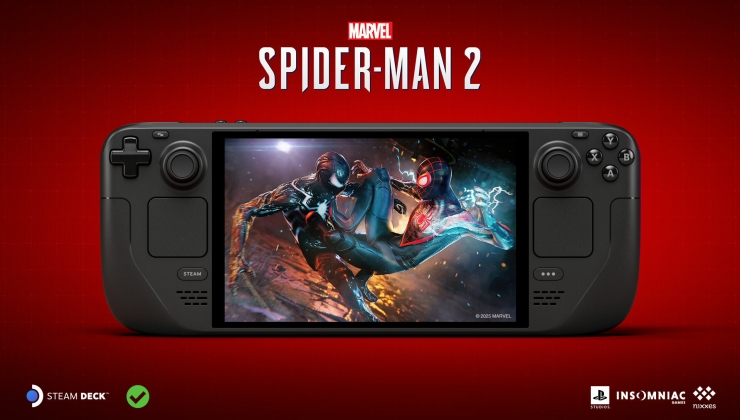Steam Deck and Steam desktop both got a fresh Beta release, with plenty of bug fixing involved and Valve are dropping support for older versions of Windows.
The changelog as expected, continues being basically the same across both, now Valve has merged the Steam Deck UI into the Desktop client, with only one changed being specific to the Steam Deck and there's no noted Linux desktop specific changes this time around.
Here's what's changed:
General
- Added "End of Life" alert for Windows 7/8/8.1. Steam Client support for these operating systems will end on Jan 1st, 2024 at 10am. See here for additional details.
- Display an error if the user is trying to log in anonymously in the client. This mode is only supported for steamcmd.
- Uninstalling a game no longer displays a modal dialog
- Fixed "Manage Storage" button opening the storage settings page
- Fix soundtrack cover art not appearing in content management panel
- Fixed popup menus opening at the wrong DPI in multi-monitor mixed-DPI configurations.
Big Picture Mode
- Removed support for -oldbigpicture command-line option
- Fixed some styling issues in the Quick Access Menu > Friends List
- Fixed some issues with notification toasts appearing in the wrong location in multi-monitor setups or with different DPI settings
- Apply text filtering preferences in Guides in the Overlay
- Removed soundtracks from All Collections since it has its own tab
- Fixed an issue where two settings pages could be visible at once
- Fixed the switching of monitors when going in/out of BPM at start up
- Fixed overflowing friends list when sharing a screenshot
- Expand the hitbox of buttons in the footer to make them easier to click
Steam Deck
- Fixed issue where a game's specific uninstall UI was not visible
Steam Input
- Increase responsiveness of the "Joystick Deadzone" visualization
- Gyro As Joystick can now optionally output to Left Joystick
- Fixed Gyro's Left/Right Stick Deflection Modifier not working
- Fixed Modeshift bindings not being removable when viewing the command on the input
macOS
- Fix Steam Overlay crash in some games using Metal graphics API
Some you may have missed, popular articles from the last month:
All posts need to follow our rules. For users logged in: please hit the Report Flag icon on any post that breaks the rules or contains illegal / harmful content. Guest readers can email us for any issues.
when 64-bit linux client
3 Likes, Who?
when 64-bit linux client
why 64-bit linux client
0 Likes
when 64-bit linux client
why 64-bit linux client
The idea is that if Steam is 64-bit (but still able to launch all those 32-bit games that will never be updated) then distros (and users) can drop all those (poorly secured) 32-bit packages that are no one wants to (or even really does) maintain.
The reasons for Ubuntu's (premature) desire to drop the maintenance and packaging of 32-bit packages at the same time as they dropped their 32-bit install images are still true, it's just that the infrastructure for ruining 32-bit proprietary applications on an entirely 64-bit system weren't yet up to the task. Without a significant push, it'll never be up to the task, and Valve dragging their feet on removing their dependency on 32-bit packages delays that push.
As I understand it.
9 Likes, Who?
when 64-bit linux client
why 64-bit linux client
The idea is that if Steam is 64-bit (but still able to launch all those 32-bit games that will never be updated) then distros (and users) can drop all those (poorly secured) 32-bit packages that are no one wants to (or even really does) maintain.
The reasons for Ubuntu's (premature) desire to drop the maintenance and packaging of 32-bit packages at the same time as they dropped their 32-bit install images are still true, it's just that the infrastructure for ruining 32-bit proprietary applications on an entirely 64-bit system weren't yet up to the task. Without a significant push, it'll never be up to the task, and Valve dragging their feet on removing their dependency on 32-bit packages delays that push.
As I understand it.
But where would all those 32 bit games get their environment from?
As I understand it, a single 32 bit game I want to run would eliminate the advantages, right?
0 Likes
when 64-bit linux client
why 64-bit linux client
The idea is that if Steam is 64-bit (but still able to launch all those 32-bit games that will never be updated) then distros (and users) can drop all those (poorly secured) 32-bit packages that are no one wants to (or even really does) maintain.
The reasons for Ubuntu's (premature) desire to drop the maintenance and packaging of 32-bit packages at the same time as they dropped their 32-bit install images are still true, it's just that the infrastructure for ruining 32-bit proprietary applications on an entirely 64-bit system weren't yet up to the task. Without a significant push, it'll never be up to the task, and Valve dragging their feet on removing their dependency on 32-bit packages delays that push.
As I understand it.
Will still need those (poorly secured) 32-bit packages for games regardless so no thats not the reason per say but will still be better for the client to be in 64 bit
1 Likes, Who?
Not that I have a lot of sympathy for Windows users but dropping 7 is going to be hard pill to swallow for some. The 10/11 compatibility with some games is apparently pretty bad.
2 Likes, Who?
I can't believe millions of PCs are left out. I didn't really expect that.
0 Likes
I don´t think Steam client needs to be 32 bits to run 32 bits Linux applications.
If you look in the Steam folder, they have a bunch of Ubuntu 32 and 64 bits libraries. They call this "Steam Runtime".
The "problem" is that this folder gets mixed with system libraries, and you also need to keep 32 bits libs installed in your system.
I remember they talking about make the Steam Runtime run in a container, like Flatpak. So Steam could just load the runtime container to keep compatibility, no need to install extra 32 bits libraries.
[Here they talk more about this](https://gitlab.steamos.cloud/steamrt/steam-runtime-tools/-/blob/main/docs/container-runtime.md)
If you look in the Steam folder, they have a bunch of Ubuntu 32 and 64 bits libraries. They call this "Steam Runtime".
The "problem" is that this folder gets mixed with system libraries, and you also need to keep 32 bits libs installed in your system.
I remember they talking about make the Steam Runtime run in a container, like Flatpak. So Steam could just load the runtime container to keep compatibility, no need to install extra 32 bits libraries.
[Here they talk more about this](https://gitlab.steamos.cloud/steamrt/steam-runtime-tools/-/blob/main/docs/container-runtime.md)
3 Likes, Who?
I don´t think Steam client needs to be 32 bits to run 32 bits Linux applications.
I don't think anybody said so, though?
My point is: If the vast majority of people is running 32 bit games, they need the environment anyway. Having the gate of making Steam 32 might even spare them some support troubles: If you can run Steam, you've got the basic setup right. The client won't profit too much from 64 bits either - it has got way larger problems than this. So, if I were Valve and would ask myself if I should make the client 64 bits, my question would be: Why would I?
0 Likes
I'm just mentioning that, in this case, games would run on top of the Steam Runtime "container". Not in your system libraries. Distributions don't need to ship 32 bit libraries only for this and Steam can even have more than one runtime. Like Ubuntu 18.04, Ubuntu 20.04, etc... Like they have for Proton versions.
Even Wine is working on running 32 bits apps on top of Wine 64 bits, without 32 bits installed on the host system. I think it is called WoW64.
I don't know if this will bring profit, probably not. Only Valve can answer that.
I just like the technology
Last edited by kuunha on 28 Mar 2023 at 3:30 pm UTC
Even Wine is working on running 32 bits apps on top of Wine 64 bits, without 32 bits installed on the host system. I think it is called WoW64.
I don't know if this will bring profit, probably not. Only Valve can answer that.
I just like the technology
Last edited by kuunha on 28 Mar 2023 at 3:30 pm UTC
4 Likes, Who?
Not that I have a lot of sympathy for Windows users but dropping 7 is going to be hard pill to swallow for some. The 10/11 compatibility with some games is apparently pretty bad.This is that moment, you sit back and notice: You have better "Windows games" compatibility on modern Linux than modern Windows.
6 Likes, Who?
Hmmm . . . so now we can say to someone "Oh, you run Windows? Well, that's OK I guess, but can you run your games?"Not that I have a lot of sympathy for Windows users but dropping 7 is going to be hard pill to swallow for some. The 10/11 compatibility with some games is apparently pretty bad.This is that moment, you sit back and notice: You have better "Windows games" compatibility on modern Linux than modern Windows.
Last edited by Purple Library Guy on 28 Mar 2023 at 4:07 pm UTC
5 Likes, Who?
Not that I have a lot of sympathy for Windows users but dropping 7 is going to be hard pill to swallow for some. The 10/11 compatibility with some games is apparently pretty bad.This is that moment, you sit back and notice: You have better "Windows games" compatibility on modern Linux than modern Windows.
That's not a new thing either, Wine has been pretty magic like that for a long time.
1 Likes, Who?
That's trueNot that I have a lot of sympathy for Windows users but dropping 7 is going to be hard pill to swallow for some. The 10/11 compatibility with some games is apparently pretty bad.This is that moment, you sit back and notice: You have better "Windows games" compatibility on modern Linux than modern Windows.
That's not a new thing either, Wine has been pretty magic like that for a long time.
A few times, I've been happily playing an older game with wine, whether from GOG or Steam and got stuck on a level and thought "I'll go check the steam forums, see what other players did" (Yeah..) and notice a bunch of threads "Game doesn't work on Windows (insert version)" or "Game crashes after launching" or "Game can't work in full screen!" etc.
Meanwhile me: "Huh, I didn't get any of that, I just clicked play."
I love the fact now that we are almost at a point where any game will "just work". So much progress, in so little time. It's awesome.
3 Likes, Who?
I can't believe millions of PCs are left out. I didn't really expect that.If you want to depress yourself:
Spoiler, click me
The number of users stranded by this move is currently bigger than the total number of Linux Steam users (1.43% + 0.34% + 0.09% = 1.86% vs 1.27%). Windows is super dominant.
0 Likes
Perhaps now is the time to enlighten those stranded users to our almighty lord Tux.I can't believe millions of PCs are left out. I didn't really expect that.If you want to depress yourself:
Spoiler, click me
The number of users stranded by this move is currently bigger than the total number of Linux Steam users (1.43% + 0.34% + 0.09% = 1.86% vs 1.27%). Windows is super dominant.
2 Likes, Who?
when 64-bit linux client
why 64-bit linux client
The idea is that if Steam is 64-bit (but still able to launch all those 32-bit games that will never be updated) then distros (and users) can drop all those (poorly secured) 32-bit packages that are no one wants to (or even really does) maintain.
The reasons for Ubuntu's (premature) desire to drop the maintenance and packaging of 32-bit packages at the same time as they dropped their 32-bit install images are still true, it's just that the infrastructure for ruining 32-bit proprietary applications on an entirely 64-bit system weren't yet up to the task. Without a significant push, it'll never be up to the task, and Valve dragging their feet on removing their dependency on 32-bit packages delays that push.
As I understand it.
But where would all those 32 bit games get their environment from?
As I understand it, a single 32 bit game I want to run would eliminate the advantages, right?
I believe the thinking is that Valve would provide them in their sandboxed "linux runtime", that way they would only be reachable for those old never to be updated anyway 32-bit games and thus could be removed from the system directories and from the distributions.
1 Likes, Who?
But where would all those 32 bit games get their environment from?
All these games can use a compatibility (like steam linux runtime). All the good 64 bit native games should only use native libraries and no runtime at all.
Valve must clean the steam client and any junk can be thrown to compatibility.
Last edited by lucinos on 29 Mar 2023 at 5:50 am UTC
1 Likes, Who?
Speculating:
since they had the idea of using a browser engine to rebase their client upon, and since that engine, chromium, will not support anything lower than windows 10 starting from the upcoming release, hey've had to stop support for the same platforms too.
Well, [the link](https://help.steampowered.com/en/faqs/view/4784-4F2B-1321-800A) in the release note say precisely this.
This change is required as core features in Steam rely on an embedded version of Google Chrome, which no longer functions on older versions of Windows.
Last edited by Breizh on 29 Mar 2023 at 3:17 pm UTC
5 Likes, Who?
Not that I have a lot of sympathy for Windows users but dropping 7 is going to be hard pill to swallow for some. The 10/11 compatibility with some games is apparently pretty bad.
Microsoft no longer supports 7 as of jan 10 2023.
And if Microsoft won’t support windows 7 why should valve 🤷🏼♂️.
And to be honest there is no reason for Microsoft to support 7 it’s old.
And I hate to say it but windows 11 has really gained on me in terms for coding.
Im forced to use it at work and there are really some thing I still hate about windows 11, but where they are aiming at atm is going to be real interesting.
Sry getting if topic here and I’m not here to preach about windows. Linux is still my nr 1 option :).
Last edited by Zelox on 30 Mar 2023 at 12:47 pm UTC
0 Likes













 How to set, change and reset your SteamOS / Steam Deck desktop sudo password
How to set, change and reset your SteamOS / Steam Deck desktop sudo password How to set up Decky Loader on Steam Deck / SteamOS for easy plugins
How to set up Decky Loader on Steam Deck / SteamOS for easy plugins
See more from me